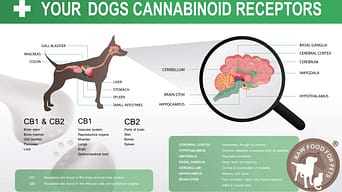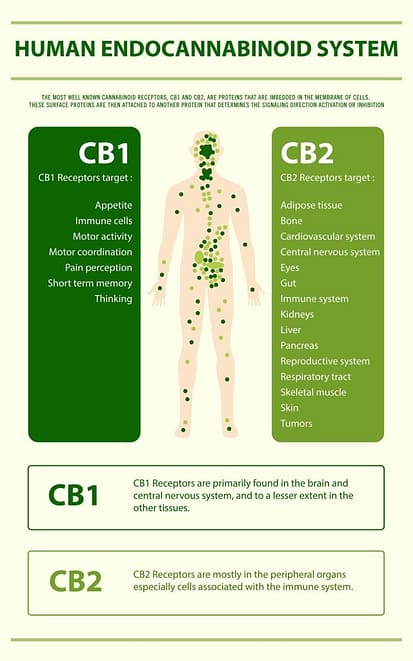The Endocannabinoid System
There is so much news about using cannabis for the treatment of disease and illness that it's easy to question the truth of the claims. How can one plant have such positive effects on diseases as different as cancer, Crohn's, epilepsy, shingles, chronic pain, MS, insomnia, Tourette's, and eczema?
These conditions all have different causes, and different symptoms. Patients are young and old and in-between.
How can one plant help so many different diseases in so many different ways?
Trying to answer these questions about how cannabis worked within the body, led scientists to discover a major regulatory system within each of us that is important in every aspect of our health. They called this system the endocannabinoid system or ECS, naming the system after the plant that led to its discovery.
What is the ECS?
The ECS is a major part of the health and healing of every creature with a backbone: that includes you, me and our cats and dogs
So, the reason for the many different effects of cannabis are because of the size and scope of the endocannabinoid system.
IT IS EVERYWHERE!
Note: Cannabis provides the same benefits to your pets it does to you. Your Vet will say it's dangerous for 2 reasons.
1. They know nothing about your pets, or their own, endocannabinoid system.
2. Their professional college doesn't know anything either and they could lose their license if they recommend it and are reported.
And I do mean EVERYWHERE!
The endogenous cannabinoid system—named for the plant that led to its discovery—is one of the most important physiologic systems involved in establishing and maintaining human health. Endocannabinoids and their receptors are found throughout the body: in the brain, organs, connective tissues, glands, and immune cells. With its complex actions in our immune system, nervous system, and virtually all of the body’s organs, the endocannabinoids are literally a bridge between body and mind.
By understanding this system, we begin to see a mechanism that could connect brain activity and states of physical health and disease.
Bradley E. Alger, Ph.D.

Courtesy Raw Food For Pets

The three components to the ECS are:
Endocannabinoids (made inside YOU) like anandamide and 2AG behave like THC and other Phytocannabinoids (plant-derived cannabinoids) on your cannabinoid receptors.
The cannabinoid receptors are called CB1 and CB2 and are found everywhere in the brain and body. CB1 receptors are mostly in the brain and central nervous system but also in our digestive system, lungs, reproductive and cardiovascular systems. CB2 receptors are found mainly in the immune system, both (CB1 & CB2) are found in the skin, bones and other tissues.
Stimulating the CB1 and CB2 receptors causes a variety of processes inside the cell.
These processes vary depending on the cell type and the cannabinoid doing the stimulating, but the final goal is always the same, homeostasis; which means keeping a stable internal environment despite changes in the external environment.
The ECS is the regulator of cellular function in health and disease from head to toe from before birth till death.
For example, At the site of an injury, cannabinoids calm the nerves in the injured tissue; this stabilizes the nerves and reduces firing lessening pain signals. Meanwhile, in nearby immune cells cannabinoids are working to stop more inflammatory substances from being released.
That's three different actions on three different cell types for a single purpose: to reduce the pain and damage sustained in the injury.

And finally, there are the enzymes responsible for the breakdown and recycling of endocannabinoids, FAAH (fatty acid amide hydrolase) and MAGL (monoacylglycerol lipase), they fine-tune the activity of the EndoCannabinoid System.
By activating the cannabinoid receptors the ECS helps regulate many of your physical processes:
“the endocannabinoid system affects the levels of all the neurotransmitters, and so it is important in pain, in emotion, whether you’re going to vomit or not, whether you’re going to have a seizure or not, almost any function you can name, and it’s not just the brain. If we look at any aspect of how our bodies work, our physiology, you’ve got some element of the ECS that affects that”.
Dr. Ethan Russo
“In strict medical terms marijuana is far safer than many foods we commonly consume. For example, eating 10 raw potatoes can result in a toxic response. By comparison, it is physically impossible to eat enough marijuana to induce death. Marijuana in its natural form is one of the safest therapeutically active substances known to man. By any measure of rational analysis marijuana can be safely used within the supervised routine of medical care.
Francis Young - DEA Administrative Law Judge - 1988
THE ILLEGALITY OF CANNABIS IS OUTRAGEOUS, AN IMPEDIMENT TO FULL UTILIZATION OF A DRUG WHICH HELPS PRODUCE THE SERENITY AND INSIGHT, SENSITIVITY AND FELLOWSHIP SO DESPERATELY NEEDED IN THIS INCREASINGLY
MAD AND DANGEROUS WORLD.
Carl Sagan
Figure 1 below shows the endocannabinoid system: its functions, distribution, and components (reproduced with permission from Elsevier)
Endocannabinoids are “short-order” neurotransmitters, meaning they are created on demand and are only produced when the body signals that they are needed, they're produced in small quantities and their existence is short, because after being released, endocannabinoids are quickly broken down by enzymes, the above mentioned FAAH and MAGL.
By contrast, when you consume cannabis, larger amounts of cannabinoids flood the brain and body causing a cascade and the resulting euphoria THC is famous for at the same time as it is doing the medicinal work on your endocannabinoid system.
Because there is more THC it sticks around longer. This means that the endocannabinoid system is activated more strongly and for longer than it would usually be if not supplemented with cannabis.

![The endocannabinoid system: its functions, distribution, and components (reproduced with permission from Elsevier) [14]](https://www.researchgate.net/profile/Piyush_Kumar7/publication/329505584/figure/fig1/AS:714416928600069@1547341677782/The-endocannabinoid-system-its-functions-distribution-and-components-reproduced-with.png)